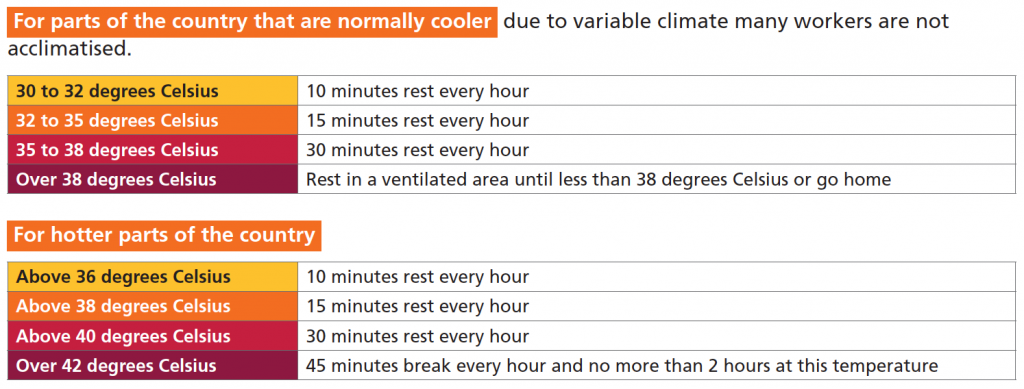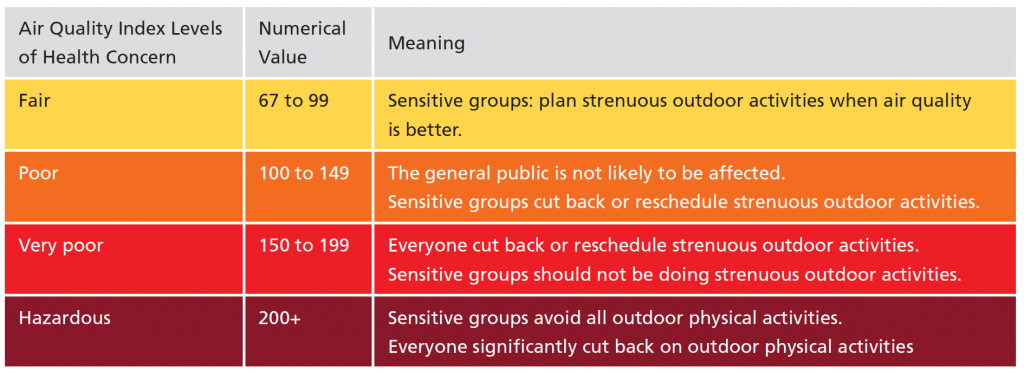Working in Heat
Every employer or Person Conducting a Business or Undertaking (PCBU) has a duty of care to “ensure the health and safety of their workers and others at the workplace.” This includes ensuring that workers are not exposed to hazardous temperatures.
Between 2005 and 2014, 13 workers died in Australia from being exposed to ‘environmental heat’ – five were in Queensland including a 40-year-old.
As the temperature rises the body becomes less able to cope with the strain, serious health risks such as:
Heat Cramps: These are painful cramps in the legs and arm muscles, the back and the stomach. They are due in part to excessive loss of salt during sweating.
Heat Rash: Skin rashes over arms, shoulders and chest and behind the knee often associated with a tingling or prickly feeling are a sign of excessive heat exposure.
Heat Exhaustion: This happens when the body loses too much water too quickly.
The blood pumped to the skin for cooling purposes depletes the brain of sufficient blood and this can cause fainting. The signs are heavy sweating (clammy skin), vomiting, paleness, dizziness, low temperature, tiredness and a weak pulse.
Heat Stroke: This occurs when the body is no longer able to control its internal temperature. Because sweating stops, a high fever results that can lead to damage to organs such as the brain, liver and kidneys.
If you or others are experiencing any of these symptoms you should seek medical advice. As the temperature rises, the likelihood of workers’ health suffering increases.
Hot temperatures cause discomfort and hazards such as:
• reduced concentration (and increased likelihood of accidents)
• increased discomfort in use of protective clothing and equipment
• aggravation of effects of other hazards, e.g. noise
• aggravation of pre-existing illnesses
• heat stress, exhaustion and fainting.
Heat discomfort is felt at 30 degrees Celsius and all efforts should be taken by employers to keep temperatures below this level or to provide conditions for outdoor workers that help reduce the effects of seasonal hot conditions where the temperature exceeds 30 degrees.
Both indoor and outdoor work measures to be taken should include:
• avoiding work in areas where workers are exposed to heat
• providing air-conditioned rest rooms
• changing the rate of work e.g. taking longer
• providing lighter alternative work
• use of air-circulating fans
• use of shade cloths
• use of trees to shade buildings and outdoor areas
• provision of constant supplies of cool drinking water.

When work cannot be re-scheduled or artificial cooling provided then a regime of rest breaks in cool areas with cool drinks is essential.
The temperatures for rest breaks will vary depending upon usual temperatures and whether workers are acclimatised. To minimise the risks, the temperature needs to be constantly monitored.
Your industry/union may have different schedules than those below that consider the type of work and conditions for your workplaces. The below is a recommendation for workers where those arrangements are NOT in place.
For parts of the country that are normally cooler due to variable climate many workers are not acclimatised.
The effects of heat are more pronounced if the air quality is poor, for example due to smoke haze. When it is hot and there is smoke haze the body spends energy keeping itself cool and coping with the effects of smoke haze. See ACTU Alert on Smoke Haze (below).
Some people may have physical or medical health conditions, making them more susceptible to
hot conditions.
Hydration
Thirst is not a reliable guide for dehydration. It’s essential to drink especially when working or exercising in the heat. Drink water, not energy or sports drinks. Urine that is light yellow is a good indication that you’re getting enough fluid.
First Aid
If someone is suffering from heat stress they must immediately report to and be given first aid. This includes resting in cooler area, keeping the skin wet and fanning to improve evaporation and cooling of the skin.
If you have concerns about exposure in your workplace contact the United Services Union on 1300 136 604.
Smoke Haze – Bushfires and Air Quality
Bushfire smoke contains a mixture of gases and very fine particles that can be hazardous to health.
Those most at risk are firefighters and outdoor workers.
The short-term health hazards include making asthma and chronic bronchitis/emphysema worse. People who suffer from chronic bronchitis/emphysema or heart conditions are at an increased risk and should take additional precautions, including staying indoors.
Asthmatics may need to use their medications more often.
Air quality is measured using an Air Quality Index (AQI). The AQI combines the measures of ozone, nitrogen dioxide, carbon monoxide, sulfur dioxide, particles PM10 and PM2.5 and visibility into a rating of air quality. PM2.5 is the smallest and usually most harmful particle.
An AQI less than 50 indicates that the air quality is good. At this low level, a person can spend time outdoors and air pollution will pose very little risk to their health. As the AQI number increases, so does the risk to human health.

Sensitive groups include people with asthma or lung problems of any kind, people with heart disease, diabetes or previous stroke, children under 14, people over 65 and people who are pregnant. Source NSW government advice.
The EPA or Health department in states and jurisdictions publishes air quality information regularly.
People most at risk from particle pollution exposure include those with heart or lung disease (including asthma and chronic obstructive pulmonary disease-COPD), older adults, and children. Research indicates that pregnant women, newborns, and people with certain health conditions, such as obesity or diabetes, also may be more susceptible to Particulate Matter (PM)-related effects.
When the AQI is above 200 it is likely that even healthy people may experience eye, throat and nose irritation, coughing, chest tightness and shortness of breath.
Exposure needs to be avoided by staying indoors with windows closed and running an air conditioner, keeping activity levels low and avoiding activities that make you breathe faster and deeper.
The steps needed to minimise exposure include:
• locating work inside or in enclosed structures/vehicles with filters effective for PM2.5 particles
• changing the place of work to where levels are lower
• reducing work time in area of unfiltered air
• increasing frequency and length of rest times and
• reducing the physical intensity of work to help lower breathing and heart rates.
Expert advice is required for any use of respiratory protection. Respirators need to be able to filter particles and fit the person’s face well. Respirators can increase health risks especially when it’s hot and physical work is involved. Those with medical conditions need medical advice before using respiratory protection.
If you have concerns about exposure in your workplace contact the United Services Union on 1300 136 604.
If you or others are experiencing any of these symptoms you should seek medical advice.




